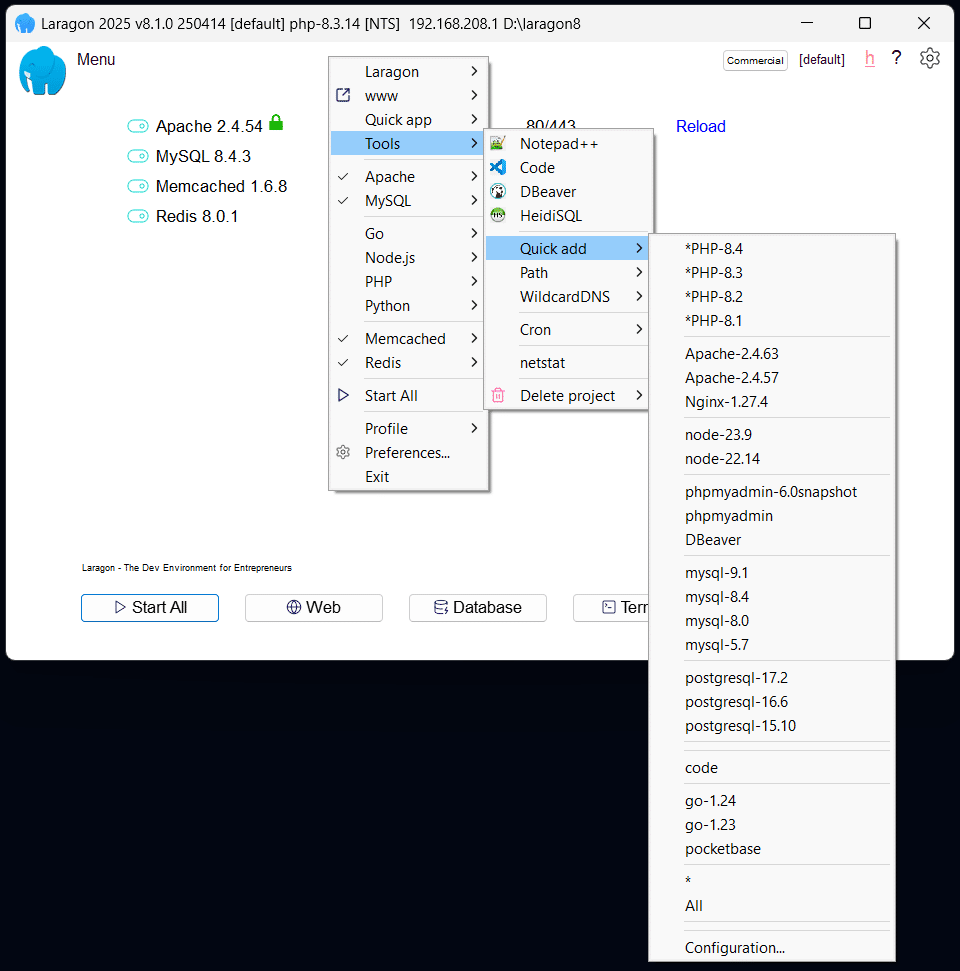If you’ve ever lost hours fighting PHP versions, busy ports, unresolved hosts, or corrupted databases, Laragon is worth a look. It’s a Windows local development environment built around three simple ideas: lightweight, portable, and reliable. It doesn’t reinvent the wheel— it removes friction: it starts in seconds, doesn’t pollute your system, creates vhosts and SSL with one click, and supports multiple versions of PHP, Node, MySQL, PostgreSQL, Apache/Nginx, and more.
Below is a practical, tech-press-style walkthrough: what Laragon brings, who it’s for, best practices, and when you might prefer something else.
What makes Laragon different
Genuinely lightweight
- The core executable is ~6 MB, and idle RAM usage sits around 4–10 MB.
- Services start/stop in seconds.
Portable and self-contained
- Everything lives in a single folder. Moving to another machine? Copy the folder, done. No installers or registry mess.
Productivity with no fuss
- Auto Virtual Hosts: maps
myapp.testautomatically, nohostsedits. - One-click SSL: instant self-signed certs (
https://myapp.test). - Quick App: spin up WordPress, Laravel, Symfony, Node.js (or your own templates) in one click.
- Profiles (Multi-Stack): switch full stacks safely (legacy vs bleeding-edge) per project/client.
- Multi-version services: run and switch PHP 8.2/8.3/8.4, Node 22/23, MySQL 8/9, PostgreSQL 16/17, Apache/Nginx… per project or profile.
Reliability & ops
- Crash-resistant MySQL and automatic backups.
- Procfile: declare auxiliary services (e.g., MeiliSearch, Redis, queue workers) that auto-start with your stack.
- Integrated terminal (Windows Terminal + Cmder) with Git, Composer, npm, pip, etc., preconfigured— no
PATHheadaches. - ngrok integration: share your local app publicly in one click for demos, remote previews, or webhook development.
Where Laragon shines
- Windows teams that need consistent environments without per-laptop admin work. Laragon is clone-and-go.
- Agencies/freelancers juggling heterogeneous projects (WooCommerce + Laravel + Node) with multi-version requirements.
- Onboarding new devs: going from “six hours of setup” to “under 30 minutes” is realistic when you package profiles and templates.
- Demos & validation: enable local HTTPS, share via ngrok, and get feedback in minutes.
A typical flow (example)
- Download/unpack to
D:\Dev\laragon(or your preferred path). - Start from the system tray → Start All.
- Menu → Quick app → Laravel →
myapi. Laragon creates the project and vhostmyapi.testwith SSL. - Menu → PHP → Version to switch to PHP 8.3 if required.
- Add a Procfile line to launch MeiliSearch and another for a queue worker.
- Menu → Share → ngrok to demo the API or receive Stripe webhooks.
Net time: minutes.
Team best practices
- Profiles per client: e.g., “Client X” (PHP 8.2 + Nginx + MySQL 8.4) vs “Client Y” (PHP 8.4 + Apache + MySQL 9.1). Toggle without breakage.
- Quick App templates: create custom starters (plugins, themes, boilerplates) so everyone begins the same way.
- Scheduled backups: enable automatic MySQL backups with retention per project/profile.
- Procfile as contract: document services (ports/deps) per project to kill “works on my machine” bugs.
- Version your environment config (excluding heavy data) for reproducibility.
Security & networking: sensible defaults
- Local self-signed certs are for dev only— don’t reuse elsewhere.
- Keep ngrok usage intentional so you don’t expose sensitive endpoints by accident.
- When sharing the Laragon folder, exclude credentials and sensitive DB dumps.
Performance & footprint
- Because it’s self-contained, Laragon doesn’t pollute the system (no global services, no PATH churn).
- It loads only what you run (services/Procfile), keeping CPU/RAM usage modest.
- Switching versions of PHP/Node/DB is instant and project-safe.
When not to use Laragon
- If your whole team is macOS/Linux, the natural picks are Dev Containers (VS Code), Docker Desktop/Colima, or WSL2 (on Windows) with Docker.
- If your app depends on Kubernetes or complex operators, prefer Docker Compose or minikube/kind to mirror real topology.
- If your CI/CD standardizes container images and per-service pipelines, aligning local with containers often simplifies lifecycle.
Tip: Laragon and Docker aren’t mutually exclusive. Use Laragon for PHP/Node projects that fit; use containers when the infra is heavier.
Quick adoption checklist
- Install Laragon in a short path (avoid long/spacey directories).
- Create Profiles per client/stack.
- Prepare Quick App templates.
- Define a Procfile per project (aux services).
- Enable automatic MySQL backups + retention policy.
- Document ports and URLs per project (vhosts).
- Enable local SSL and test
http→httpsredirects. - Set an internal ngrok policy (who/when/why).
Quick comparison (Laragon vs local alternatives on Windows)
| Criterion | Laragon | XAMPP/WAMP | Local by Flywheel | Docker Desktop |
|---|---|---|---|---|
| Portability | Single copyable folder | System-wide install | App bundle | Images/compose |
| Multi-version (PHP/DB/Node) | Yes (per profile/project) | Limited | Limited | By image |
| vHosts + one-click SSL | Yes | Manual/limited | Yes | N/A (use a reverse proxy) |
| Auxiliary services | Procfile | Manual | Limited | Compose/K8s |
| CLI integration (Git, Composer, npm) | Preconfigured | Partial | Partial | In-container |
| One-click sharing (ngrok) | Yes | No | No | Manual |
Bottom line
Laragon nails what hurts most on Windows: fast startup, painless version switching, no system pollution, and setup times measured in minutes. For teams juggling WordPress, Laravel, Symfony, or Node, and craving consistency without friction, it’s a strong choice. It won’t replace Docker/Kubernetes when your architecture demands it, but it covers a huge slice of real-world projects with a hard-to-beat productivity/footprint ratio.
If your day-to-day is building, testing, and shipping, Laragon is that “it just works” layer that lets you focus on what matters: creating, building, and innovating—not wasting time on configuration.

